
In Modoc County, farm workers do a job few people have ever seen. For eight hours, they lie on padded platforms on each side of an elaborate metal apparatus, suspended just inches above rows of strawberry plants. As a tractor slowly pulls them through the field, the workers pick off the flowers and budding fruit – not to harvest them – but to keep the plants from producing more.
The plants they’re tending in this unique operation are seedlings. Eventually they’ll be uprooted, the dirt will be knocked off their roots, and they’ll be sent to cavernous warehouses. There, other workers will trim the roots to an even length. Then the plants will be packed into containers and shipped to the strawberry growers of Watsonville, California, or Mount Vernon, Washington, or out of the country entirely.
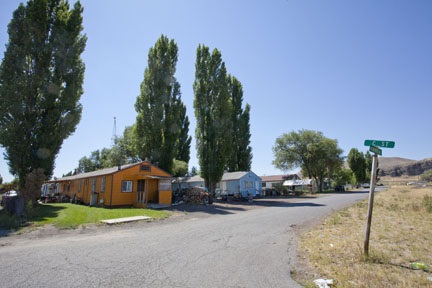 Workers’ homes on the land that was formerly the Tule Lake Internment Camp. (Photo: David Bacon).Today big commercial strawberry growers often don’t grow their plants from seeds. It takes too long. In addition, growers formerly killed the nematodes that infect the roots of young strawberry plants by covering fields in plastic sheets, then injecting methyl bromide or methyl iodide into the soil. Those two extremely poisonous chemicals are now being banned in state after state, because they contribute to depleting the ozone layer, which protects life on this planet.
Workers’ homes on the land that was formerly the Tule Lake Internment Camp. (Photo: David Bacon).Today big commercial strawberry growers often don’t grow their plants from seeds. It takes too long. In addition, growers formerly killed the nematodes that infect the roots of young strawberry plants by covering fields in plastic sheets, then injecting methyl bromide or methyl iodide into the soil. Those two extremely poisonous chemicals are now being banned in state after state, because they contribute to depleting the ozone layer, which protects life on this planet.
So the seedlings are grown separately. Farm workers migrate from towns in more populated areas of California into this county, at the far northern end of the state, to lie on the platforms and pinch off the flowers. “It’s a good six months of work,” explains Elpidio Gonzalez, one of the workers. “I can go back to Stockton with enough money for the rest of the year, especially if I can find a little work in the winter pruning grapes. The only disadvantage is that there’s really no place to live here for migrants. I share a trailer with a bunch of others, and we were lucky to find it.”
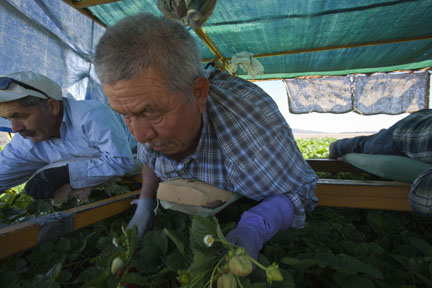 Older workers, with experience and skill, are needed for this job. (Photo: David Bacon).Gonzalez and his coworkers on the machine are Mexican immigrants, but most of them have been living in the US for years. This industry, however, uses guest workers as well. The county’s largest grower, Sierra Cascade, with 1,000 acres planted in strawberry rootstock, brings laborers to Modoc directly from Mexico, using the H2A contract labor program. In 2006, Sierra Cascade was sued by those workers, represented by California Rural Legal Assistance (CRLA), over bad housing and living conditions.
Older workers, with experience and skill, are needed for this job. (Photo: David Bacon).Gonzalez and his coworkers on the machine are Mexican immigrants, but most of them have been living in the US for years. This industry, however, uses guest workers as well. The county’s largest grower, Sierra Cascade, with 1,000 acres planted in strawberry rootstock, brings laborers to Modoc directly from Mexico, using the H2A contract labor program. In 2006, Sierra Cascade was sued by those workers, represented by California Rural Legal Assistance (CRLA), over bad housing and living conditions.
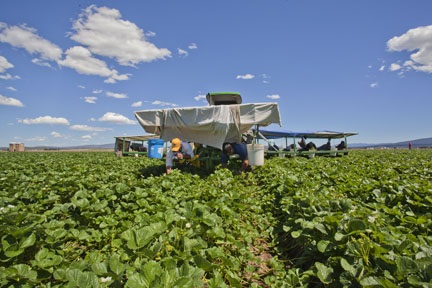 A tractor carrying the workers on platforms moves through the field. (Photo: David Bacon).
A tractor carrying the workers on platforms moves through the field. (Photo: David Bacon).
Under the H2A program, growers have to provide housing and give the workers a contract that specifies the months of work they’ll get. Sierra Cascade began by putting them into a warehouse on the county fairgrounds. There, life was grim. “During the first two weeks, on many occasions, we would have a cup of coffee for breakfast, a small portion of greasy tough meat with rice for lunch, and cereal, coffee and bread with jelly for dinner,” Ricardo Valle Daniel recalled. After the workers got in touch with the CRLA lawyers, the food got better. But in the warehouse, couples were housed in a cavernous room where many men and women were mixed together, despite company promises of family quarters.
These workers had been hired under nine-week contracts to trim the root of the plants after they’d been unearthed. The contracts specified they’d have to meet production standards requiring them to process more than 1,000 plants per hour – one every three and a half seconds. When some workers couldn’t meet the quotas, even when they worked through their meal breaks, Sierra Cascade fired them and put them on buses back to Mexico. Although the legal case eventually improved conditions somewhat, a state court judge ruled that the production quotas were legal. The workers had no way to keep the company from firing (and deporting) them for not working at that rapid rate. Today Sierra Cascade continues to bring in H2A workers for its root-trimming operation, and the quota is still in place.
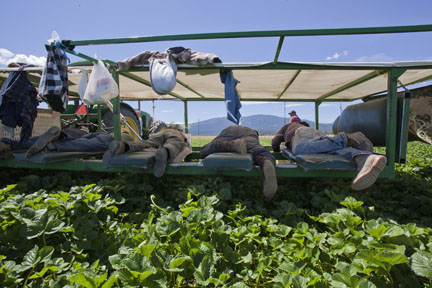 Each wing of the machine holds platforms for four workers. (Photo: David Bacon).Housing the workers in the fairgrounds was more than ironic. The Tule Lake grounds is home to a small museum devoted to the Tule Lake Internment Camp, where 18,000 Japanese-Americans, most US citizens, were imprisoned during World War II. The museum preserves one of the hundreds of barracks that originally housed the internees. Visitors can peek through plexiglas windows and see the austere furnishings – military-style metal bed frames, unadorned table and chairs, a plain chest of drawers.
Each wing of the machine holds platforms for four workers. (Photo: David Bacon).Housing the workers in the fairgrounds was more than ironic. The Tule Lake grounds is home to a small museum devoted to the Tule Lake Internment Camp, where 18,000 Japanese-Americans, most US citizens, were imprisoned during World War II. The museum preserves one of the hundreds of barracks that originally housed the internees. Visitors can peek through plexiglas windows and see the austere furnishings – military-style metal bed frames, unadorned table and chairs, a plain chest of drawers.
The warehouse where the H2A workers were housed in 2006 was not one of the original barracks, and the fairgrounds itself isn’t the site of the internment camp. That is in a huge empty plain, not far from the modern borders of Tule Lake itself, in the tiny hamlet of Newell, seven miles south.
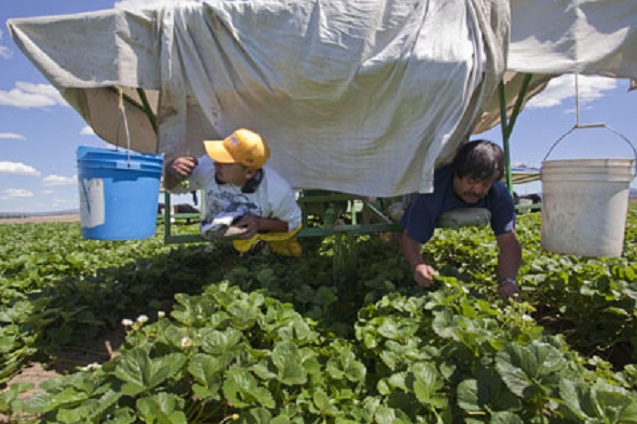 Farm workers on platforms in front of the tractor. (Photo: David Bacon).
Farm workers on platforms in front of the tractor. (Photo: David Bacon).
Almost nothing is left of the original camp. After the war, most of Tule Lake itself was drained. The “reclaimed” land was auctioned off as farm homesteads to World War II veterans. The internment camp was closed and residents were dispersed – none wanted to remain in an area that held such bitter memories. The barracks were cut in half, and each family that was awarded a homestead was given a half as a home starter.
But a few of the barracks were left in place in Newell. They’ve become housing for low-income families, many of them farm workers. Over the years, they’ve been painted in brighter colors, perhaps so they won’t immediately remind anyone of their origins. But the poverty of the families who live in them can’t be as easily disguised.
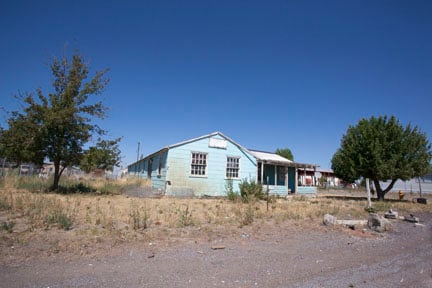 Houses like this on the old internment camp land were originally barracks for internees. (Photo: David Bacon).After the war, a few growers in Tule Lake brought in braceros, under the contract guest worker program that was ended in 1964. That bracero program is the direct ancestor of today’s H2A guest worker scheme. In the museum, there’s no mention where those braceros lived or how many there were. Maybe some lived in the old transplanted barracks, too.
Houses like this on the old internment camp land were originally barracks for internees. (Photo: David Bacon).After the war, a few growers in Tule Lake brought in braceros, under the contract guest worker program that was ended in 1964. That bracero program is the direct ancestor of today’s H2A guest worker scheme. In the museum, there’s no mention where those braceros lived or how many there were. Maybe some lived in the old transplanted barracks, too.
Eventually Modoc County built a little housing for migrant workers – a group of cabins called the Newell Migrant Center. They were built on the ground where the barracks of the old interment center were. This year, no one was living in the camp. The gates were locked, and it was closed. Migrants such as Gonzalez had to find trailers or motel rooms on their own in Tule Lake, Dorris and Macdoel, the farm worker towns of this valley.
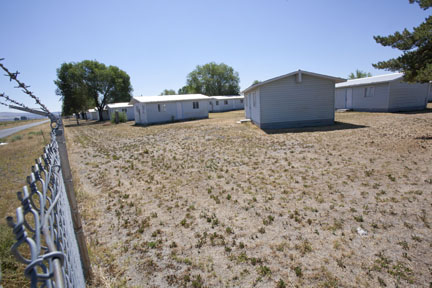 Behind the barbed-wire fence – the vacant cabins of the Newell Migrant Center. (Photo: David Bacon).The empty cabins of the Migrant Center are a strange sight – empty homes surrounded by a tall fence, topped by barbed wire. The old internment camp barracks also must have been surrounded by barbed wire fences – perhaps even in the same locations. Many internees were also farm laborers, not just before they were imprisoned but even during their incarceration, when they grew the food consumed by the camp’s residents. Internee farm workers even organized a strike one year over abusive conditions, which turned into a general strike of camp residents. Camp managers brought in other internees to break that strike, housing them in another small internment camp a few miles away. Then the government brought Italian and German prisoners of war to Tule Lake, contracting them out to local growers for farm labor. And then, after the war ended, growers brought in the braceros.
Behind the barbed-wire fence – the vacant cabins of the Newell Migrant Center. (Photo: David Bacon).The empty cabins of the Migrant Center are a strange sight – empty homes surrounded by a tall fence, topped by barbed wire. The old internment camp barracks also must have been surrounded by barbed wire fences – perhaps even in the same locations. Many internees were also farm laborers, not just before they were imprisoned but even during their incarceration, when they grew the food consumed by the camp’s residents. Internee farm workers even organized a strike one year over abusive conditions, which turned into a general strike of camp residents. Camp managers brought in other internees to break that strike, housing them in another small internment camp a few miles away. Then the government brought Italian and German prisoners of war to Tule Lake, contracting them out to local growers for farm labor. And then, after the war ended, growers brought in the braceros.
Today, Congress is debating bills that would make the H2A program look like small potatoes – expanding the number of recruited workers many times over, possibly even reaching the 500,000 worker peak of the bracero program in the mid-1950s. The bill recently passed by the Senate, and other bills in the House, would even lower the legally mandated wage that H2A workers receive. These bills would eliminate the current housing guarantee, as miserable as that sometimes is. These new guest workers would get instead a rent “subsidy,” putting them into competition with traditional migrants like Gonzalez for the small trailers of Macdoel or Tule Lake. Maybe the county would open and expand the Newell migrant camp. Sierra Cascade undoubtedly would like that idea.
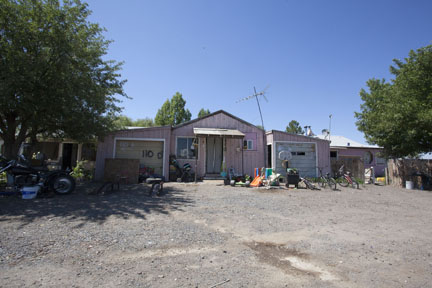 Residents paint bright colors on their converted barracks homes. (Photo: David Bacon).It’s hard to travel through Tule Lake without thinking about the way people have been dehumanized here because of their race, national origin and class. History here is written into the soil beneath the old and new barracks, and under the strawberry plants themselves. But Tule Lake isn’t some special case, and the worst abuses of today take place far from here.
Residents paint bright colors on their converted barracks homes. (Photo: David Bacon).It’s hard to travel through Tule Lake without thinking about the way people have been dehumanized here because of their race, national origin and class. History here is written into the soil beneath the old and new barracks, and under the strawberry plants themselves. But Tule Lake isn’t some special case, and the worst abuses of today take place far from here.
When war hysteria took hold with the invasions of Iraq and Afghanistan, people from the Middle East and South Asia were thrown into prison with as little regard for their rights as there was for the rights of the Japanese half a century earlier. Now there are camps surrounded by barbed wire for hundreds of thousands of deportees, who can languish there for months and even years. The hysteria that demonizes Mexicans who come across the border to work, especially those that come on their own without papers, often forces them into brutal living conditions that are worse than those of the braceros. And Congress’ answer is replicating and expanding contract labor programs, just as the growers did after World War II or as Sierra Cascade does today. In Tule Lake you can see what that reality looks like.
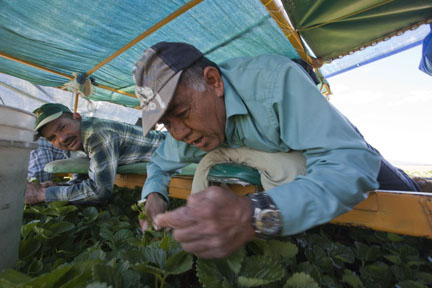 Workers lie only a few inches above the plants they’re trimming. (Photo: David Bacon).But the internment camp gates did finally open, and people were freed. The old bracero program did end – the year after the March on Washington we just celebrated. Today you can see Mexican families coming out of the church across from the fairgrounds and hear young people call out to each other in the soft evening. If there’s a future for Tule Lake, they are it. Tule Lake could be a good place for them to live, whether they’re here all year around or just come for a few months work.
Workers lie only a few inches above the plants they’re trimming. (Photo: David Bacon).But the internment camp gates did finally open, and people were freed. The old bracero program did end – the year after the March on Washington we just celebrated. Today you can see Mexican families coming out of the church across from the fairgrounds and hear young people call out to each other in the soft evening. If there’s a future for Tule Lake, they are it. Tule Lake could be a good place for them to live, whether they’re here all year around or just come for a few months work.
© Copyright by David Bacon.
Join us in defending the truth before it’s too late
The future of independent journalism is uncertain, and the consequences of losing it are too grave to ignore. To ensure Truthout remains safe, strong, and free, we need to raise $50,000 in the next 9 days. Every dollar raised goes directly toward the costs of producing news you can trust.
Please give what you can — because by supporting us with a tax-deductible donation, you’re not just preserving a source of news, you’re helping to safeguard what’s left of our democracy.